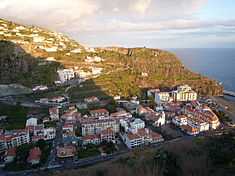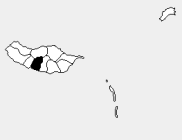Ribeira Brava, Madeira
| Ribeira Brava | |||
| Municipality (Concelho) | |||
 Main centre of Ribeira Brava along the valley of the same name, and at the coast | |||
|
|||
| Official name: Concelho da Ribeira Brava | |||
| Name origin: ribeira brava, Portuguese compound word for rough/unsettled ravine | |||
| Country | |||
|---|---|---|---|
| Autonomous Region | |||
| Island | Madeira | ||
| Civil Parishes | Campanário, Ribeira Brava, Serra de Água, Tabua | ||
| Landmark | Church of São Bento | ||
| Center | Ribeira Brava | ||
| - coordinates | 32°39′N 17°4′W / 32.650°N 17.067°W | ||
| Lowest point | Sea level | ||
| - location | Atlantic Ocean | ||
| - elevation | 0 m (0 ft) | ||
| Area | 65.1 km2 (25 sq mi) | ||
| Population | 12,494 (2001) | ||
| Density | 191.29 / km2 (495 / sq mi) | ||
| Municipality | 6 May 1914 | ||
| LAU | Concelho/Câmara Municipal | ||
| President | José Ismael Fernandes (PSD) | ||
| Municipal Chair | João Luís Drumond Henriques (PSD) | ||
| Timezone | WET (UTC0) | ||
| - summer (DST) | WEST (UTC+1) | ||
| ISO 3166-2 code | PT-30- | ||
| Postal Zone | 9350 Ribeira Brava | ||
| Area Code & Prefix | (+351) 291 XXX-XXXX | ||
| Demonym | Madeirense; Ribeira-bravense | ||
| Patron Saint | São Bento | ||
| Municipal Address | Rua do Visconde, 56 9350-213 Ribeira Brava | ||
| Municipal Holidays | 29 June | ||
 Administrative location of the municipality of Ribeira Brava in the archipelago of Madeira
| |||
| Wikimedia Commons: Ribeira Brava | |||
| Website: http://www.cm-ribeirabrava.pt | |||
Ribeira Brava (Portuguese pronunciation: [ʁiˈβɐjɾɐ ˈβɾavɐ]) is a municipality on the island of Madeira, in the Portuguese Autonomous Region of Madeira. It is located along the southern coast (approximately center), and is west of Câmara de Lobos and the regional capital Funchal. In 2001 its population was about 12500 inhabitantas in various agglomeration, covering an area of 65.1 km2 (there were about 191.29 inhabitants/km²).
Geography

_following_heavy_rain%2C_Ribeira_Brava%2C_Maderia%2C_Portugal.jpg)
The municipalities raison d'etre, the Ribeira Brava ravine and river valley extends 10-12m from the slopes of the west-central mountains of Madeira. Its waters provide the primary sources of drinking-water (a small reservoir collect surface run-off) to the area and electricitiy to the island of Madeira. Approximately ten tributaries feed this river, whose course ends in the Serra de Água, and much later empties into the Atlantic along the village's coast.
The primary urban agglomerations are the four civil parishes, constituted with their own local government, and located along regional roadways. They include:
- Campanário
- Ribeira Brava
- Serra de Água
- Tabua
Economy
Agriculture and the fishery are the important economies that support the villages in this region, although commercial services localized in the central village (also called Ribeira Brava) provide daily support for locals.

